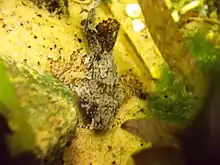Erethistidae
Erethistidae are a family of catfishes that originate from southern Asia.[2] It includes about 45 species.
| Erethistidae | |
|---|---|
 | |
| Erethistes pusillus | |
| Scientific classification | |
| Domain: | Eukaryota |
| Kingdom: | Animalia |
| Phylum: | Chordata |
| Class: | Actinopterygii |
| Order: | Siluriformes |
| Superfamily: | Sisoroidea |
| Family: | Erethistidae Bleeker, 1862 |
| Genera[1] | |
|
Ayarnangra | |
Taxonomy
This family includes species previously placed in Sisoridae.[2] They were removed because they were thought to be more closely related to the neotropical Aspredinidae than to the remaining sisorids due to a number of morphological characters.[3] However, it has been suggested that the erethistid catfishes be included back into Sisoridae and some genera are included in that family by some authorities.[4]
Distribution
Erethistids are found on the Indian subcontinent eastwards to western Thailand and northern Malay Peninsula.[5]
Description
Many of the members of this family are small, cryptically colored fishes with tuberculate skin.[5] Erethistids are distinguished from sisorids by having a pectoral girdle with a long coracoid process that extends well beyond the base of the pectoral fin; this structure can be felt through the skin in all genera and is visible externally in all genera except Pseudolaguvia. Erethistids differ from amblicipitids in that they lack a cuplike fold of skin in front of the pectoral fin (vs. possessing the cuplike fold), and have a dorsal fin with a strong spine and no thick covering of skin (vs. a weak spine with a thick covering of skin). Erethistids have nostrils close together, separated by a nasal barbel, which differs from akysids which have widely separated nostrils on each side of the head, with a barbel on the posterior nostril.[6] Some erethistids possess a thoracic adhesive apparatus formed by longitudinal skin folds densely covered with unculi that appears to be an adaptation to life in fast flowing waters; this closely resembles a similar structure in the sisorid Glyptothorax.[7]
References
- Froese, Rainer, and Daniel Pauly, eds. (2011). "Erethistidae" in FishBase. December 2011 version.
- Nelson, Joseph S. (2006). Fishes of the World. John Wiley & Sons, Inc. ISBN 0-471-25031-7.
- Diogo, R.; Chardon, M.; Vandewalle, P. (2003). "Osteology and myology of the cephalic region and pectoral girdle of Erethistes pusillus, comparison with other erethistids, and comments on the synapomorphies and phylogenetic relationships of the Erethistidae (Teleostei: Siluriformes)". Journal of Fish Biology. 63 (5): 1160–1175. doi:10.1046/j.1095-8649.2003.00235.x.
- Ferraris, Carl J. Jr. (2007). "Checklist of catfishes, recent and fossil (Osteichthyes: Siluriformes), and catalogue of siluriform primary types" (PDF). Zootaxa. 1418: 1–628. Retrieved 2009-06-25.
- Ng, Heok Hee (March 2005). "Conta pectinata, a new erethistid catfish (Teleostei: Erethistidae) from northeast India" (PDF). Ichthyol. Explor. Freshwaters. 16 (1): 23–28. Retrieved 2009-06-25.
- Thomson, Alfred W.; Page, Lawrence M. (2006). "Genera of the Asian Catfish Families Sisoridae and Erethistidae (Teleostei: Siluriformes)" (PDF). Zootaxa. 1345: 1–96. Retrieved 2009-06-25.
- Britzi, Ralf; Ferraris, Carl J. Jr. (2003). "A new species of the Asian catfish genus Pseudolaguvia from Myanmar (Teleostei: Ostariophysi: Siluriformes: Erethistidae)" (PDF). Zootaxa. 388: 1–8. Retrieved 2009-06-25.